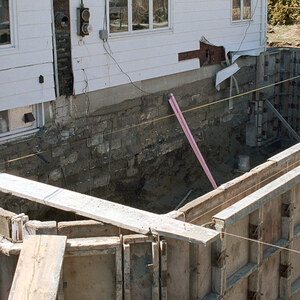I am trying to find the source of water coming down the face of a chimney and have ruled out flashing at roof. Is there a good product to seal old masonry joints? This is my next area of attack. I have installed step flashing under the shingles and cut copper step flashing into the mortar joints. Water still runs down exposed chimney inside the house. Could mortar joints be that porous. Thanks for any help
Discussion Forum
Discussion Forum
Up Next
Video Shorts
Featured Story

Learn more about the benefits and compliance details for the DOE's new water heater energy-efficiency standards.
Featured Video
How to Install Cable Rail Around Wood-Post CornersHighlights
"I have learned so much thanks to the searchable articles on the FHB website. I can confidently say that I expect to be a life-long subscriber." - M.K.

















Replies
Anything is possible.
But b/4 you goop up anything, hows the top of that chimney look?
Do you have a cap over the flue pipe? Is the wash caulked at the flue penetration?
Is there a cricket on the uphill side ?
Do you have a picture or two you could post here?
There is no cricket but the chimney is only 2ft wide and about 14ft long. Low pitch, probably no more than 4/12. Cap over flue pipe but just a rounded over layer of concrete over the top of the whole chimney. No sign of any flashing. No pics yet. Thanks
How does your chimney stack up to the attached
Bill, how is that through flashing under the cap "attached" to the liner?
If you tink you have a tuck pointing problem,....test it.
If you have ruled out flashing at the roof and the cap/flue interface, it could well be leaking motar joints and/porous brick.
Weak motar joints are ussually soft or have cracks showing where they touch the brick at the bed and head joints. Sometime you can slip the point of a pocket knife into the cracks. Other times the motar is so soft and crumbly it can be easily excavated with that same pocket knife.
If wind driven rain hits those areas the water will wick through the joints and run down the inside of the brick veneer. Efforvescents occurs when the water migrates back through the brick because there is no place for it to drain out. Depending on the porosity of the brick and construction methods efforvesents does not always occur. Sometimes the water just leaks through the first place it can find, inside or outside of the chimney.
A simple garden hose spray test will tell you if you have a tuck pointing issue.
More later if you are interested.
Gotta go do a job fer de boss.
I'm thinking this is what is
I'm thinking this is what is happening. Moss growing out of some of the joint not a good sign. Don't know if sealer would fix problem or joints need to be re-done. Thanks
If moss or other matter is growing in the joints, I'd cut them out and repoint. Moss like other plant life needs moisture. It'll send out roots to get it. The deeper the roots, the deeper the leak source.
Sealing something in that condition may work for a while. But if you are like me, we're not getting younger. Make the trips now up the roof..
Best of luck in finding the source. Garden hose is a way to go. But don't just flood the whole are at once. Start low and work your way up in elevation. Do you have access in the attic that you can narrow down the location on the chimney higher up as it comes in?
There is no attic in this part of roof. Roof deck is 2x6 t&g and is also the ceiling so I don't think there is a lot of damage being done. During a rain storm water does more than just seep through, it actually runs down the front of the chimney in a few places so I should be able to pinpoint location. Thanks
There is no attic in this part of roof. Roof deck is 2x6 t&g and is also the ceiling so I don't think there is a lot of damage being done. During a rain storm water does more than just seep through, it actually runs down the front of the chimney in a few places so I should be able to pinpoint location. Thanks
What Calvin said on testing it with a water hose.
Repointing a chimney is not for the faint hearted. You need an angle grinder with a diamond blade (there is even a stacked double blade that is made for this). Cut/grind out the bed and head joints about 3/4" deep. Then use a pointing trowel to pack new mortar back in and restrike them. Be sure to brush or blow the dust out of the cut joints before repointing. when all of the pointing is done and set for a few days, goe back and spray the whole thing with a good sealer.
(if you want the mossy look, there is a good formula for growing moss on several sites, but it is a waste of good beer imo)
:-)